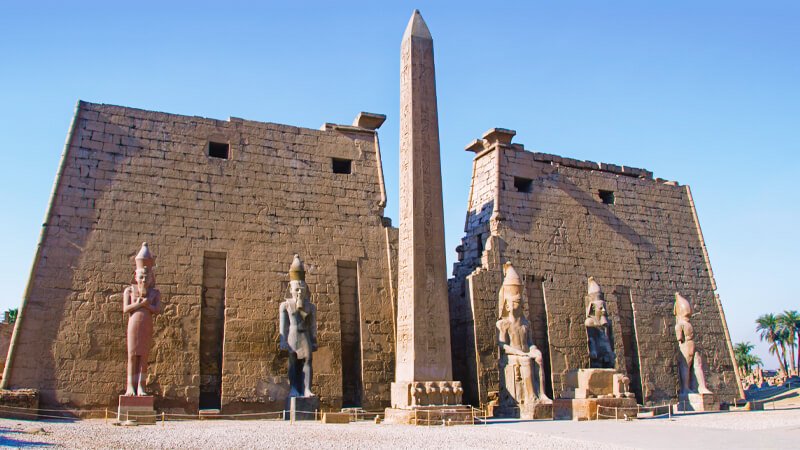Luxor Temple stands as one of Egypt’s most iconic and well-preserved ancient structures, located on the east bank of the Nile River in the modern city of Luxor. The temple is not just a monumental religious site but also a testimony to the glory of ancient Egyptian civilization.
Constructed primarily during the reign of Pharaoh Amenhotep III, it was later expanded by several rulers, including Tutankhamun and Ramses II. The temple was dedicated to the rejuvenation of kingship and played a central role in religious festivals, especially the annual Opet Festival. Travelers to Egypt can marvel at its colossal statues, towering columns, and intricate hieroglyphics that offer a glimpse into the grandeur of the past.
This article will guide you through the history, architecture, and significance of Luxor Temple, while offering insights for modern-day visitors.
The Historical Significance of Luxor Temple
Luxor Temple, known as “Ipet Resyt” in ancient Egyptian, meaning “the southern sanctuary,” holds deep historical significance. Built around 1400 BCE during the 18th Dynasty, the temple was dedicated to the Theban triad of deities: Amun, Mut, and Khonsu.
However, unlike many temples in Egypt, Luxor Temple was not dedicated to a specific god but to the concept of divine kingship. Pharaohs came here to be crowned, reinforcing their status as gods on earth. The temple complex also played a vital role in the Opet Festival, where the deities of Karnak Temple were transported to Luxor Temple, symbolizing the renewal of life and the monarchy. Over the centuries, various rulers, including the Romans, added to its grandeur, making it a living historical monument.
The Architecture of Luxor Temple
The architecture of Luxor Temple is nothing short of awe-inspiring. Its layout follows the traditional design of an Egyptian temple, with a grand entrance marked by a massive pylon built by Ramses II. Two colossal statues of Ramses II flank the entrance, welcoming visitors into the grandeur of ancient Egypt. Once inside, travelers are greeted by a long avenue of sphinxes, which originally connected Luxor Temple to the nearby Karnak Temple.
The temple’s inner sanctum houses massive columns, some of which still bear the vibrant colors they were originally painted in. The hypostyle hall is particularly striking, with its tall columns decorated with intricate carvings depicting the gods and pharaohs. This unique blend of architectural styles, spanning centuries, adds to the temple’s historical richness.
The Avenue of Sphinxes: Connecting Luxor and Karnak Temples
One of the most fascinating features of Luxor Temple is the Avenue of Sphinxes, which once stretched for 2.7 kilometers, connecting Luxor Temple to Karnak Temple. This grand ceremonial road, lined with over a thousand sphinx statues, was used during the Opet Festival to transport statues of deities between the two temples.
Each sphinx represents a lion’s body with a human head, symbolizing the strength of the pharaoh. Recently restored, the Avenue of Sphinxes is now accessible to visitors, offering a tangible link between these two monumental sites. Walking this ancient path is like stepping back in time, allowing travelers to experience the grandeur of ancient Thebes.
Luxor Temple and the Opet Festival
The Opet Festival was one of the most important religious celebrations in ancient Egypt, and Luxor Temple played a central role in its rituals. The festival, which took place annually, was a celebration of the divine kingship and the renewal of life.
Statues of the gods Amun, Mut, and Khonsu were transported in ceremonial boats from Karnak Temple to Luxor Temple via the Avenue of Sphinxes. The procession symbolized the rejuvenation of the pharaoh’s divine power and the unity of the gods and the people. For modern travelers, understanding the significance of the Opet Festival adds a deeper layer of appreciation when visiting Luxor Temple, as it brings to life the spiritual and cultural vitality of ancient Egypt.
The Role of Ramses II in Luxor Temple’s Expansion
Pharaoh Ramses II, one of Egypt’s most powerful and long-reigning rulers, left a lasting mark on Luxor Temple. His contributions to the temple are evident in the grand pylon, the massive statues of himself, and the striking obelisk that once stood at the entrance (one of which is now in the Place de la Concorde in Paris).
Ramses II’s additions to Luxor Temple were meant to immortalize his reign and ensure his legacy. His influence is felt throughout the temple complex, from the detailed carvings of his military victories to the numerous statues that depict him in the guise of a god. For visitors, the presence of Ramses II in Luxor Temple offers a fascinating glimpse into the life and ambitions of one of Egypt’s most legendary pharaohs.
Luxor Temple Under Roman Rule
Luxor Temple continued to be a significant religious site even after the decline of ancient Egypt. Under Roman rule, the temple was converted into a military fortress, and a Roman legion was stationed here. The temple also became the site of an early Christian church, and later, a mosque was built within its walls, which still stands today. The Roman emperors, including Augustus, added their own touches to the temple, incorporating Roman-style architecture and inscriptions alongside the traditional Egyptian elements. This blending of cultures and religions over the centuries makes Luxor Temple a unique historical site that showcases the evolution of religious and political power in Egypt.
The Mosque of Abu Haggag
One of the most interesting features of Luxor Temple is the Mosque of Abu Haggag, which was built during the 13th century on top of part of the temple complex. The mosque is dedicated to Abu Haggag, a Muslim saint who is revered in the region.
The unique coexistence of the mosque and the ancient temple demonstrates the layered history of Luxor and the various cultures that have influenced it. Despite being built centuries after the temple’s construction, the mosque remains an active place of worship, adding a modern dimension to this ancient site. For travelers, the mosque is a symbol of the enduring spiritual significance of Luxor Temple across different eras and faiths.
The Restoration and Preservation of Luxor Temple
Luxor Temple has undergone extensive restoration and preservation efforts over the years to protect its ancient structures from the ravages of time. Archaeologists and historians have worked tirelessly to restore the temple to its former glory, ensuring that future generations can continue to marvel at its beauty.
The restoration of the Avenue of Sphinxes, in particular, has been a major undertaking, with efforts to excavate and reconstruct the sphinx statues along the ceremonial road. These preservation efforts are crucial in maintaining Luxor Temple as one of Egypt’s most important historical and tourist sites. Visitors today can appreciate the careful work that has gone into preserving this ancient wonder, allowing them to experience the temple much as it would have appeared thousands of years ago.
Tips for Visiting Luxor Temple
For travelers planning a visit to Luxor Temple, there are several key tips to ensure a memorable experience. First, it’s best to visit early in the morning or late in the afternoon to avoid the heat, as Luxor can get quite hot, especially during the summer months. The temple is beautifully lit at night, making evening visits a magical experience.
Additionally, hiring a knowledgeable guide can enhance your visit by providing in-depth information about the temple’s history, architecture, and significance. Comfortable walking shoes, sunscreen, and plenty of water are essential for exploring the vast complex. Lastly, don’t miss the chance to walk the Avenue of Sphinxes, which connects Luxor Temple to Karnak Temple, for a complete experience of ancient Thebes.
Conclusion: Luxor Temple’s Timeless Appeal
Luxor Temple stands as a symbol of Egypt’s ancient grandeur and its enduring cultural significance. From its intricate carvings and towering columns to its role in the Opet Festival and its connections to other iconic landmarks like Karnak Temple, Luxor Temple offers travelers a deep dive into the heart of ancient Egyptian civilization.
Whether you’re a history enthusiast or simply a curious traveler, a visit to Luxor Temple is an unforgettable journey through time. Its architectural beauty, historical importance, and spiritual significance make it a must-see destination for anyone visiting Egypt, providing a unique window into the world of the pharaohs and the rich history of the Nile Valley.

